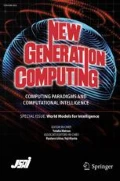Abstract
To implement diverse and partial flow of information in cognitive processes, we need a design method without explicit stipulation of domain/task-dependent information flow, together with a control scheme for guiding information processing to concern only important information depending on contexts.
A computational architecture is proposed which is based on a first-order logic program with a dynamics. The declarative semantics of the logic program is defined by measuring the degree of violation in terms ofpotential energy, and a control scheme for both analog and symbol computation is derived from the resultant dynamics, which replaces domain/task-dependent procedures, hence avoiding intractable complexity in the system design. This inherent integration of the control scheme with the declarative semantics guarantees that inferences are naturally centered around relevant information in a context sensitive manner. The essence of inference mechanisms proposed so far, such as weighted abduction and marker passing, are also subsumed by this dynamical control. All this justifies further exploration for improving this sort of formalism to deal with large, real-world problems.
Similar content being viewed by others
References
Anderson, J. R.,The Architecture of Cognition, Harvard University Press, Cambridge, 1983.
Charniak, E., “A Neat Theory of Marker Passing,” inProceedings of AAAI’86, pp. 584–588, 1986.
Charniak, E. and Shimony, E. S., “Probabilistic Semantics for Cost Based Abduction,” inProceedings of AAAI’90, pp. 106–111, 1990.
Hobbs, J., Stickel, M., Appelt, D., and Martin, P., “Interpretation as Abduction,”Technical Note 499, SRI International, 1990.
Norvig, P., “Marker Passing as a Weak Method for Text Inferencing,”Cognitive Science, 13, pp. 569–620, 1989.
Pineda, F. J., “Generalization of Backpropagation to Recurrent and Higher Order Neural Networks,” inNeural Information Processing Pystems (D. Z. Anderson, ed.), pp. 602–611, 1988.
Shieber, S. M., van Noord, G., and Moore, R. C., “A Semantic-Head-Driven Generation Algorithm for Unification-Based Formalisms,” inProceedings of the 27th Annual Meeting of the Association for Computational Linguistics, pp. 7–17, 1989.
Smolensky, P., “Tensor Product Variable Binding and the Representation of Symbolic Structuresin Connectionist Systems,”Artificial Intelligence, 46, pp. 159–216, 1990.
Stickel, M. E., “Rationale and Methods for Abductive Reasoning in Natural-Language Interpretation,” inProceedings, Natural Language and Logic, International Scientific Symposium (R. Studer, ed.),number 459 in Lecture Notes in Artificial Intelligence, Springer-Verlag, pp. 233–252, 1989.
Suttner, B. C. and Ertel, W., “Automatic Acquisition of Search Guiding Heuristics,” inProceedings of the 10th International Conference on Automated Deduction (CADE), pp. 470–484, 1990.
Turetzky, D. S., “BoltzCONS: Dynamic Symbol Structures in a Connectionist Network,”Artificial Intelligence, 46, pp. 5–46, 1990.
Waltz, D. and Pollack, J., “Massively Parallel Parsing: A Strongly Interactive Model of Natural Language Interpretation,”Cognitive Science, 9, pp. 51–74, 1985.
Author information
Authors and Affiliations
Corresponding author
Additional information
An extension of ‘Dynamics of Symbol Systems: An Integrated Architecture of Cognition’ (1992) inProceedings of FGCS’92, pp. 1141–1148.
Dr. Kôiti Hasida: He received a doctoral degree from The University of Tokyo in 1986. He has been affiliated with Electrotechnical Laboratory since 1986, and also with ICOT for 4 years from 1988. His research interest includes natural language processing, linguistic theories, intelligent agent architecture, multi-agent cooperation/communication, massively parallel artificial intelligence, cognitive modeling, and so forth. He is presently working on a computational/behavioral architecture encompassing all of them, by which he hopes to bridge the gap between artificial intelligence and the real world.
About this article
Cite this article
Hasida, K. Dynamics of symbol systems. New Gener Comput 12, 285–310 (1994). https://doi.org/10.1007/BF03037346
Received:
Revised:
Issue Date:
DOI: https://doi.org/10.1007/BF03037346




